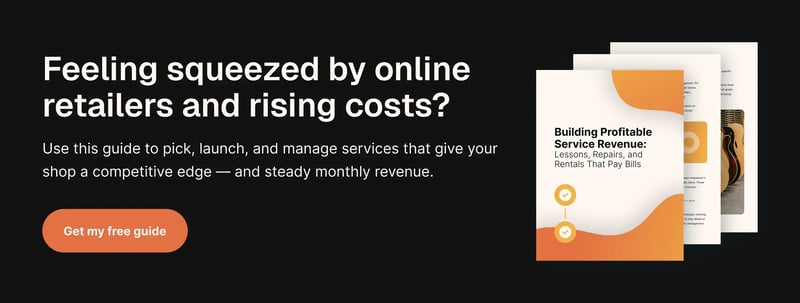
Thinking about upgrading your point of sale (POS) system?
If you’ve been using a legacy POS system for a while, it might be time. While legacy systems that store your data on-premises were once top-of-the-line, new cloud-based solutions connect to Wi-Fi and open up a whole new range of features.
With a cloud-based system, you can browse music supplier catalogs, update product information, and keep inventory up to date from any Wi-Fi-enabled device. It’s a game-changer for running your store — but it’s also a big change for you and your employees.
One of the most common concerns for business owners switching to a cloud-based system is preserving their data. If you’ve been running your music store for years, you likely have an archive of records that’s valuable to the business — and the idea of losing them can be quite concerning.
But here’s the good news: With Music Shop 360, you don’t have to worry about losing your data. Our expert data migration team is here to seamlessly transfer all your existing records to your new system, ensuring no crucial information is left behind.
In this blog, we’ll guide you through the data migration process, so you make the upgrade with confidence and without disruption.
Let’s get started.
Concerns With Data Migration
Changing to a new POS can seem overwhelming for a number of reasons — even if the new system has the features you need. Data migration is a key (and understandable) concern, so let’s take a look at some of the most common worries and how we address them here at Music Shop 360.
Loss of Data
Our data migration specialists preserve and transfer everything they can, but most businesses don’t have “clean” — or complete and error-free —data at the time of migration.
It’s normal to have inconsistent business records. This happens naturally over time, and is a result of many factors. If several employees are inputting inventory, they may use different formats. There might be multiple codes for the same product, leading to confusion and duplicates. For example, a guitar that you only have one of might be in the system three separate times.
Data naturally degrades over time, too, and it’s a migration specialist’s job to resolve these issues when they transfer your records. This is referred to as “data cleanup.”
So, yes, some product entries or customer profiles may not be in a state to be transferred to your new system. However, migration specialists can eliminate incomplete data and merge duplicates, which means your records will likely end up in a better state than when you began the migration process.
Related Read: How To Create a Product and Vendor Catalog With Music Shop 360
Business Disruption
You might be worried that the transition period will be disruptive to business. But, while the Music Shop 360 team is training you and your employees on the new POS and migrating your data, you can still handle business on your old system.
The onboarding process usually takes a few weeks. During this time, you’ll learn and practice with the system to make sure you’re comfortable before your “go live date,” when you’ll fully implement it at your music store. During this process, data migration specialists go through your records to prepare them for export to your new system.
Meanwhile, you can still use your existing POS to make sales, receive inventory, and regularly carry out business tasks so there’s no disruption to revenue.
Related Read: Training Staff in Your Music Store: 7 Tips for Success
Too Much Time & Effort
Our migration specialists want to ease the load as much as possible. We’ll work with you to retrieve the data, then clean it up and export it to your new POS. We do the heavy-lifting, so you can focus on learning the new system and running your music store.
The Migration Process
When you onboard with Music Shop 360, you’re assigned a data migration specialist. You can schedule a time to video chat with the specialist to discuss your data needs.
We’ve migrated data for hundreds of businesses, and have seen nearly every POS system out there — which means we know how to resolve issues quickly and ensure all relevant data is exported.
To start the process, your migration specialist will ask what data you'd like to export. You may not need all records to be transferred, especially if you know a set of data isn’t accurate or up to date.
These data points are commonly transferred:
- Product catalog
- Customer profiles
- Sales data
Customer purchase histories can be more difficult to export than other data — they can be retrieved from an existing POS system about 80% of the time. Purchase histories are helpful for marketing to existing customers — for example, if a customer rented or purchased trumpets in the past, you can send them marketing emails when you stock new trumpets or other brass instruments.
We also have tools for locating and resolving issues like errors, inconsistencies, and duplicates, so when it’s sent to your new system, it’s more accurate and useful.
When a business’ data has been migrated and the staff is fully trained on the system, it’s time to “go live.” Before you officially start using the software, we’ll do a final sync to bring all data up to date. Then, you’re off to the races.
Related Read: 15 Email Marketing Ideas for Your Music Store
Of course, this doesn’t mean you’re on your own. Even with extensive training, getting used to the system in practice takes time. When you have questions or run into issues, you can call Music Shop 360’s support line during scheduled hours for help.
Migrate Your Data Stress-Free With Music Shop 360
We get it: It can be overwhelming to upgrade from a legacy system to a comprehensive cloud solution. You may be concerned it’ll be difficult for you and your employees to learn, and that you might lose valuable company information. These concerns are normal, but with Music Shop 360, you have access to extensive training and full data migration.
Exporting records from your existing POS to a new one is a process, but with a dedicated migration specialist, you can extract your data and clean it up so it’s in better shape than ever. Soon, you’ll have all of the features of a cloud-based system, and still have the data your business needs. And even after the setup process is complete, you have continued access to customer support if you do run into issues.
Ready to get started? See Music Shop 360 for yourself by scheduling a live demo today.



 by
by 




